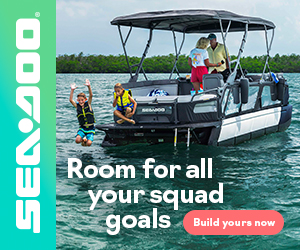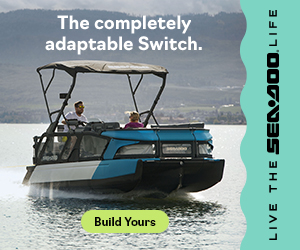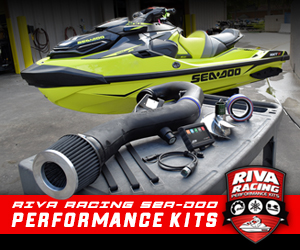When it comes to ride plates for Kawasaki Ultra JetSkis, Jamie Eade, the owner of Kspeed out of Brisbane, Australia, has found the secret recipe (after many prototypes and countless hours of testing). The Watercraft Journal first reported the details of the new KS3 ProRace Ride plate back in April of 2023, but it was not until recently that WCJ was able to get his hands on one for a real-world test.
Kspeed’s original KS1 ride plate achieved global acclaim, but was not compatible with the new Kawasaki Smart Reverse and Deceleration (KSRD) system now standard on new Ultra 160 and 310 JetSkis. So, Kspeed went back to the drawing board and “re-engineered and refined the original design.”
The KS3 ProRace Ride Plate promises “a perfect blend of offshore and high-speed performance, combined with improved handling in rough water conditions.” So JD Brussels from JD’s WaterWorld took to the water on two separate videos to test it out for himself on the Kawasaki Ultra 310 LX-S JetSki.
Die-hard Ultra fans aren’t particularly concerned about flat water performance, so for the first round of testing, we ventured out on the ocean. We all know that Ultra’s thick and durable SMC fiberglass hull is designed with a 22.5 degree deadrise for slicing through waves, while Kawasaki’s patented Quattro Splash Deflector (QSD) displaces chop and spray efficiently and smoothly.
Many riders remark that the Ultra platform rides a bit low at the bow. Even Kevin Shaw posted videos of a gold 2022 Ultra 310 LX “submarining” at low speed. The KS3 ProRace ride plate provides corrective action for the Ultra’s tendency to “dip” at the bow by changing how water passes under the JetSki. This effect is apparent even at lower speeds and gives the ski a “lift kit” feel.
Compared to the stock ride plate, which measures 15-inches in length and includes a “ramp” area that equates to 5-inches, the Kspeed plate measures a total of 18-inches. A large sloping 8-inch “ramp” area provides aggressive lift even at lower speeds, while the Kspeed plate extends an additional 3 inches than the stock plate, past the end of the jet pump steering/trim nozzle.
So why would someone want an expensive ride plate over a relatively cheaper pump wedge? A pump wedge achieves bow lift by changing the angle of the pump nozzle thereby “bending” the jet stream and directing that water upwards- which causes the bow to ride higher in the water.
 Now don’t get us wrong, the Kspeed 2-degree pump wedge is a great option for those looking for extra bow lift, but it comes at a cost. By “bending” that water coming out of the jet pump, you are causing a slight degree of parasitic loss.
Now don’t get us wrong, the Kspeed 2-degree pump wedge is a great option for those looking for extra bow lift, but it comes at a cost. By “bending” that water coming out of the jet pump, you are causing a slight degree of parasitic loss.
By utilizing a ride plate, you can maintain a neutral pump nozzle alignment and trim setting while reaping the benefits of having your bow higher out of the water.
The JetSki will literally plane on the larger surface area of the Kspeed ride plate – getting a larger portion of that deep-V Ultra hull out of the water and contributing to less drag – which allows the vessel to travel at a higher rate of speed.
Besides reducing drag, getting the bow up and out of the water allows the Ultra to cruise over wake and chop more effectively.
Rather than striking the ski directly on the bow, waves and wake strike the Ultra directly on the QSD molded splash deflectors- which contributes to a drier and smoother ride for the operator.
When it comes to smooth water performance, JD recorded an average speed of 73 mph across 8 different speed runs. The Ultra 310 LX-S sustained a top sustained speed of 75mph at 8,000 RPM utilizing the Kawasaki GPS Engine Information Display. JD is a 6’2’’ 215lbs. rider and the ski contained 1/3 a tank of premium 93 octane fuel. Unfortunately, JD was unable to test the ride plate on “glass” and testing was done during a 100-degree South Florida summer, so conditions were far from ideal.
As previously reported on The Watercraft Journal, JD achieved a sustained top speed of 72mph with the Kspeed Stage 1 Kit alone; that means that the Kspeed ProRace KS3 ride plate contributed to a 3mph gain under similar testing conditions. These results are consistent with Kspeed’s marketing claims, and can be achieved with only moderate upgrades to your ski that won’t void your factory warranty or destroy your engine over time.
JD concluded that the KS3 ProRace ride plate “radically improves the handling characteristics of the Ultra 310″ by “getting the bow up and out of the water,” and contributing to drier ride overall. There is a definite tradeoff between getting the bow out of the water and keeping the jet pump hooked up in the chop.
JD did lose a bit of hookup in the chop (evidenced by the repeated redline scream of the TVS supercharger) but ironically he claims he was still able to maintain a faster top speed with less fatigue while flying through chop at nearly 55mph off the coast of Jupiter Island.
For JD’s initial testing he had both a Kspeed 2-Degree pump wedge and the KS3 ProRace ride plate installed on his Ultra 310. JD felt that both of these provided “a bit too much lift” and so he removed the 2-degree pump wedge and stuck with just the ride plate. The IJSBA Race-Legal KSpeed KS3 ProRace Ride Plate retails for $409 USD plus shipping. Note that this only fits 2022+ Kawasaki Ultra 310 and 2023+ Kawasaki Ultra 160 JetSkis.























